Pervasive Services in New-generation Internet: Mechanisms and Key Technologies
Zhang Hongke,Yang Dong,Dong Ping
(Next Generation Internet Research Center, School of Electronics and Information Engineering, Beijing Jiaotong University, Beijing 100044, China)
Abstract:The original infrastructure of the Internet can no longer meet personalized and diversified demands of current increasing network subscribers.It has exposed many defects and shortcomings.For examples,the mechanism of using ports to distinguish services is inflexible and dangerous with the emergence of various services;the current Internet architecture does not make use of the close relationship between network resources and services,but simultaneously maintains two processing systems for the resources and services respectively,wasting both subscribers'time and network resources;the Internet class of services granularity is not fine enough,failing to meet personalized and diversified user demands.In order to solve these problems,this paper discusses the mechanisms and key technologies for pervasive services in the new-generation Internet.The paper focuses on the definition,classification and identifier design of personalized and diversified user services.The service identifier design fulfills the unified identifier and processing of various network services,discovers the close relationship between services and resources,and can offer personalized and diversified services according to users'demands.
W ith the development of the information society,the Internet has become one of the most successful technology achievements.It has been a part of people's daily life.However,its original architecture design can no longer meet increasing demands on personalized and diversified services.Therefore,the Internet infrastructure urgently requires a great change.
First,the current Internet does not make full use of the relationship between services and network resources.Resource acquisition and service access are mainstream applications in the Internet,which support almost all the network activities.However,the current architecture lacks unified description and processing mechanism for resources and services.Moreover,the resources and services in the Internet indeed have close relationship.A better discovery of their relationship may provide users with more convenient service and resource integrated processing mechanism,and may avoid the waste of network resources caused by performing two processing systems for services and resources separately.However,the current Internet lacks research and implementation of this relationship discovery.
Second,the current Internet has no unified description of different application tasks.This design defect pushes the simple concept“port number”to undertake too many functions[1].The port number is originally designed to distinguish different data streams.However,various services have been emerging along with the rapid development of the Internet,and people need an identifier to describe different services.Under such a background,the port number is given the second function—identifying Internet services.But the service distinguishing is incompatible with the meaninglessness feature of the originally designed port number[2]:
(1)The port number must identify a service by one-to-one mapping.
(2)Attacks aiming at the port number require due care.
(3)Operators can restrict any applications through the port number[3],which kills the openness and flexibility of the Internet.
Third,the disunity of service modes causes great waste of network resource and users'time.With the rapid development of information network technologies and people's increasing demands on communications,various network services have mushroomed.It can be seen that services have different implementation modes,different types and different terminal orientation.These services lead to bad service compatibility,poor scalability and difficult management of unified service control,bringing duplication of similar infrastructure and huge resource waste.
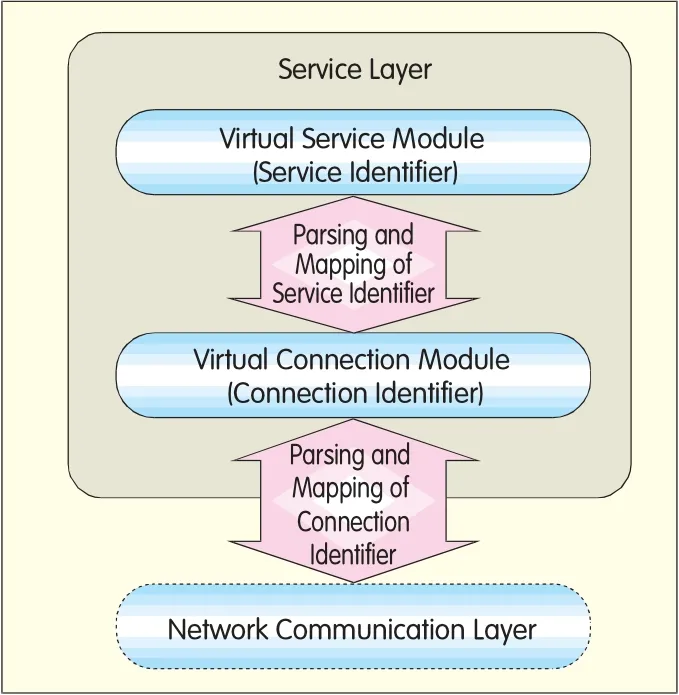
▲Figure 1. The general service layer model in the universal network.
Last,the Internet class of services granularity is not fine enough.In the current Internet,subscribers have more diversified and higher demands on services.Therefore,the class of services will be one of the major features of the new-generation Internet.With the class of services,different service requests will be fulfilled with different Quality of Service(QoS)levels.
To solve the mentioned problems,it is necessary to create a new Internet infrastructure that supports pervasive services.Anew network system—“Universal Network and Pervasive Service”is proposed in[4],and the pervasive services in this system are defined and described in[5]with the creation of a general service layer model in Universal the network.As depicted in Figure 1,the service layer model introduces a virtual service module and a virtual connection module,as well as parsing mapping of service identifier and that of connection identifier.The virtual service module is a basis for fulfilling pervasive services.It is used for unified service object scheduling,and provides service controllability and manageability,enabling multi-service support.The virtual connection module defines the connection identifier,which enables the service layer to wellsupport mobility and security,and new transport protocols fit for real-time applications such as voice and video services.
This paper,based on the achievements in[5],studies the mechanisms and key technologies for pervasive services in the new-generation Internet,focusing on the principles,mechanisms and specific technologies for the virtual service module at the service layer.As a basis of fulfilling pervasive services,the virtual service module welldiscovers the relationship between network services and data,defines the service identifier,unifies identifiers,handles different types of network services,introduces the service identifier supporting QoS,and ultimately fulfills the personalization and diversification of user services.
1 Unified Description of Services and Resources
Before,to identify Internet services,it is necessary to study the characteristics of the services,and to define and classify them.The resources in the Internet can be divided into data and services.Data acquisition and service access have become the leading applications in the current Internet[6].The new-generation Internet in the future will be data-oriented,and services will be means to acquire data.Data and services,mushrooming with the development of the Internet and higher demands of users,do not individually exist,but have close relationship.For example,when a user searches the song“Hotel California”,he may want to get different services based on the data of“Hotel California”,such as downloading it by ftp,playing it online,and buying CD with the song online.The resource discovery mechanism of the current Internet only supports the matching of key words,but pay no attention to the relationship between resources and data.
This paper,based on the universal network service system,will innovatively find the relationship between data and services,closely associating the definition and classification of services with data.
The universal service system creates service ontologies[7-8],establishes the relationship between data,services,data attributes and service attributes,and classifies available network services into interactive services and non-interactive services,as shown in Figure 2.Interactive services,such as VoIPand Messenger services,fulfillthe interaction of a user with other individuals.By interactive contents,they can be further divided into instant messages,files,voice,video and more.Non-interactive services fulfill the interaction of a user with servers.By the server types,they can be further divided into http,ftp,mail and more,which are expanding with the development of the Internet.
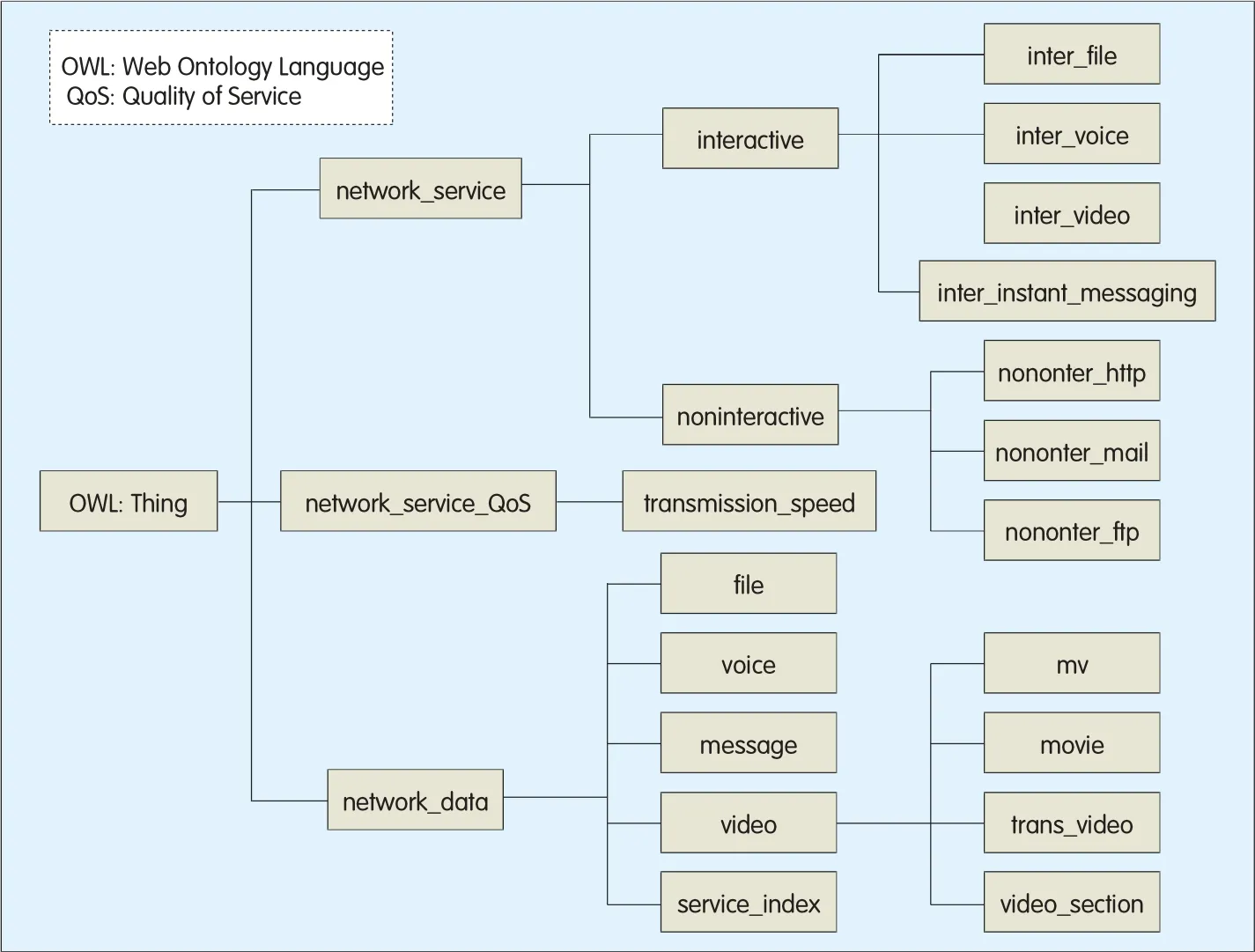
▲Figure 2. The process of defining and classifying services.
Defining and classifying user services can be completed in four steps:
Step 1:Defining ontology-based layers
·Defining father classes of network services and resources,including network_data,the father class of all the resources in the Internet,network_service,the father class of all the services in the Internet,and network_service_QoS,the father class of QoS
·Defining son classes of network_data,including video,voice,files,messages,etc.,and adding service_index,functioned as the service index
·Defining son classes of network_service,which are classified into interactive and non-interactive
·Predefining transmission_speed,a representative son class of network_service_QoS
·Defining son classes of interactive services under network_service according to interactive contents,including inter_video,inter_instant_message,inter_file,inter_voice,etc.
·Defining son classes of non-interactive services under network_service according to server types,including non-inter_http,noninter_mail,non-inter_ftp,etc·Son classes of non-inter_http are non-inter_http_video,non-inter_http_voice and non-inter_http_webservice by features
·Son classes of video services under network_data are video_section,movie,mv and trans_video by features Step 2:Defining ontology attributes
·Defining the attribute“via”,which represents the service mode used to provide data.Its definition domain is network_data,and value domain is network_service.
·Defining other attributes.According to service features,the attribute”has_QoS_speed”will be added to represent the level of a service data rate.Its definition domain is network_service,and value domain is transmission_speed.
·Defining any required object attributes and data attributes
Step 3:Users register what data and services they can offer at the registration center.
Step 4:The user ends searching for network resources.
·Typical search by resource names
·Search by resource attributes when a user does not know the resource names
·Search by the has_QoS_speed value level of a service when a user wants to get certain QoS
·Fulfilling complex inference by combining ontologies
Services and resources are closely related based on their attributes,so as to describe them in a unified way.When a user searches a service,the service and resource unified description mechanism will provide the user with often-used service information related to what he is searching;besides,the search is based on key words.In this way,the system may fulfill convenient,semantic and intelligent user service.
2 Service Identifier Design
Based on the unified description of network services and resources,the service identifier design plays a crucial role in the new network platform,“Universal Network and Pervasive Service”,fulfilling unified description of services and providing different users with different QoSlevels.
2.1 Principles of Service Identifier Design
The universal network and pervasive service is essentially designed to support different types of services.Therefore,distinguishing QoS[9-11]of different services is very important.Moreover,the core task of the service layer is to provide network users with friendly and usable services.Successfully extracting understandable interface parameters the network users concern most out of complex network service parameters is the core of the design.The usable interface parameters with distinctive features will play an important role in the design of the service layer.Therefore,the universalnetwork has the designs of user perceivable QoSand service identifier supporting QoStransfer.As shown in Figure 3,the network communication layer provides the service layer with QoS support,including user perceivable QoS and service QoS;the final QoSwill present in the service identifier,and be transferred to lower layers by the service identifier.
Figure 4 instantiates mapping relations of the QoSlayers.The service identifier design aims to fulfill these instantiations.
2.2 Basis of Service Identifier Design
In order to exactly define the service identifier,it is necessary to study the functions and working principles of the service identifier in the universal network,which is also the important basis of the service identifier design.
Figure 5 depicts the basic working principles of the service layer based on the virtualservice module and the virtual connection module.Figure 6 shows the working flow of the service layer,and also depicts the function of the connection identifier in a mobile environment.The whole working process of the service layer can be divided into four phases as follows:
(1)Phase 1:Service Registration
The structure for service registrationmay be abstracted as a triple tuples.The three elements are access identifier,service identifier and service description.
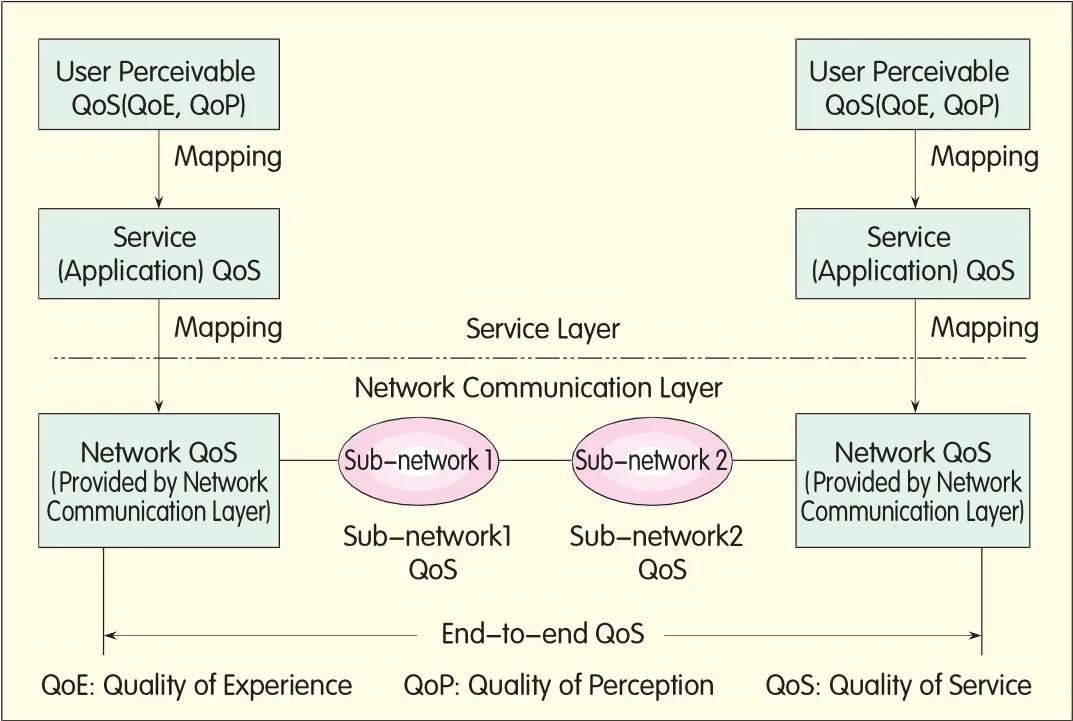
Figure 3. ?A layered QoS model of the universal network.
The access identifier is an identifier of the communications terminal's location,presenting the concept of the network communication layer in the universal network.The service identifier is the service description of communications terminals,used for establishing service connections.The service description is user-friendly,presenting users'favorite services.The server for service provisioning submits the triple tuples to the unified service processor to complete service registration.
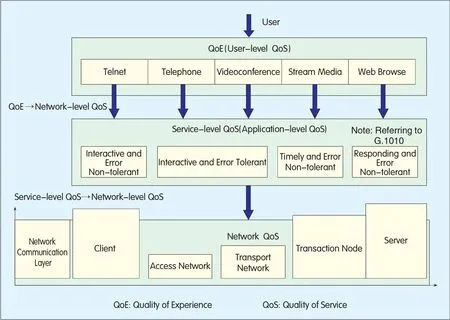
▲Figure 4. Instantiation of the QoS layers mapping.
(2)Phase 2:Service Discovery
The phase finishes the following tasks:
·A user submits a required service description to the unified service processor.
·The unified service processor gains corresponding triple tuples from the registered service.
·The unified processor sends the two elements(access identifier and service identifier)out of the triple tuples back to the user.
(3)Service Establishment
The following tasks are completed in this phase:
·The service provider uses its registered service identifier to perform connection detection.
·The service acquirer uses the corresponding service identifier to establish a service connection with the service provider.
(4)Phase 4:Service Maintenance
After a service connection is established,the communications parties make stream integration of data packets in this phase.The current Internet uses the set interface that consists of the IP address and the port number in Phase 3 and Phase 4.Differently,the universal network defines the connection identifier to distinguish data streams,and to solve the problem of service interruption caused by IPaddress change in a mobile environment.
The design mentioned above has the following innovations:
·It introduces a unified processor for third-party services.A service provider may change the service identifier anytime,only if he reregisters.This innovation overcomes the shortcomings of well-known port numbers.
·It introduces independent local connection identifier with uniform random number,distinguishing service connection and service maintenance.
·The connection identifier separates from the host identification,cracking the problem of service continuity in mobile environments.
The service identifier is mainly used for service registration and connection.It has unified service processor end,server end and client end.
The server end uses the service identifier for service detection,waiting for the access of the user who wants to acquire this service.The service identifier is created at the server end;the server creates it according to the QoS requirement of the service.
The unified service processor requires to maintain the triple tuplesregistered in the server,including the service identifier that is same with that at the server end.
The client end is complicated.The service identifier it gets from the unified service processor only presents the QoS requirement of the service itself.Besides,the client also has some simple and perceivable requests on QoS.Therefore,the client end willhandle the service identifier from the unified service processor to integrate the QoS requirement of the service and perceivable QoSrequirements of the client,and then transfer it to the lower layer to offer QoSsupport.This paper names the service identifier at the server end as the server-end service identifier,and the integrated one at the client endas the client-end service identifier.

Figure 5.?The fundamental process of service layer.
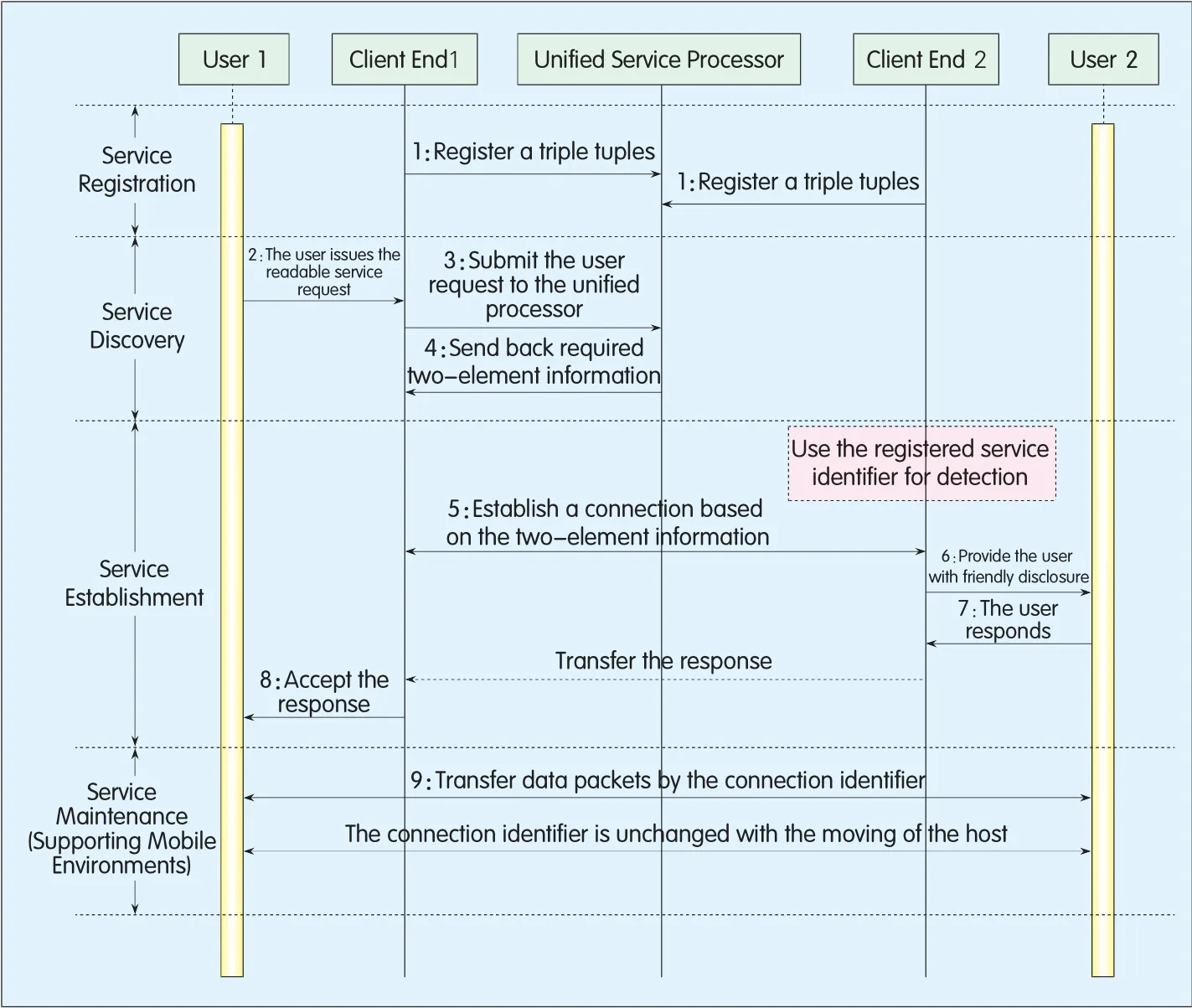
▲Figure 6. The service layer working flow chart.
2.3 Creation of Client-end Service Identifier
The client-end service identifier is defined jointly by the server-end service identifier and the user's requirements.The universalnetwork uses the designs of user perceivable QoSand service identifier supporting QoStransfer.As shown in Figure 3,the network communication layer provides the service layer with QoSsupport,including user perceivable QoSand service QoS;the final QoSshould be presented in the service identifier,and transferred to the lower layer by the service identifier.
3 Service Profile Model with QoS
The new-generation Internet—the universal network—provides services that are quite different from those offered by the current Internet.The difference,and also a distinctive feature of the universal network,is that different services in the network have different QoSlevels.
Compared to the current Internet platform,the Universal Network and Pervasive Service platform features different services provisioning with different QoSlevels,so as to fulfill the personalization and diversification of services.
A service profile model is created to implement the class of services concept in the service identifier design,as shown in Figure 8.
From the angle of network,the service profile model defines five attributes for QoS:delay,reliability,QoSspectrum,scalability and capacity.
Delay is the time interval between submitting a service request and handling the request.It is classified into three grades:
·delay≤5 s(for interactive services)·5 s<delay≤60 s(for respond sevices)
·delay>60 s(for services insensitive to delay)
Reliability is the capability of a service to implement its functions in a given time and given conditions.According to the threshold valueτ,reliability is classified into three types:
·reliability is far less thanτ
·reliability is approximate toτ·reliability is far more thanτ The QoSspectrum includes accelerated transfer,guaranteed transfer and best-effort transfer.
The scalability shows the number of operations handled by a service in a given time.
The capacity is the number of requests simultaneously handled by a service.
These attributes are defined from the angle of network,so it is difficult for users to understand or use them.For this reason,Table 1 gives the mapping relationship between network and users,that is,the mapping relationship between user request and network provision.
The service profile model divides QoS into requester QoSand provider QoS:the former describes a user's requirement on service level;the latter is the description of QoSacquired from the service provider in the network.
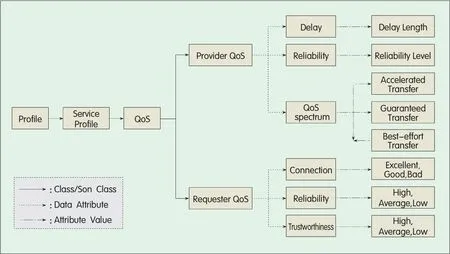
▲Figure 7. The service profile model with QoS.
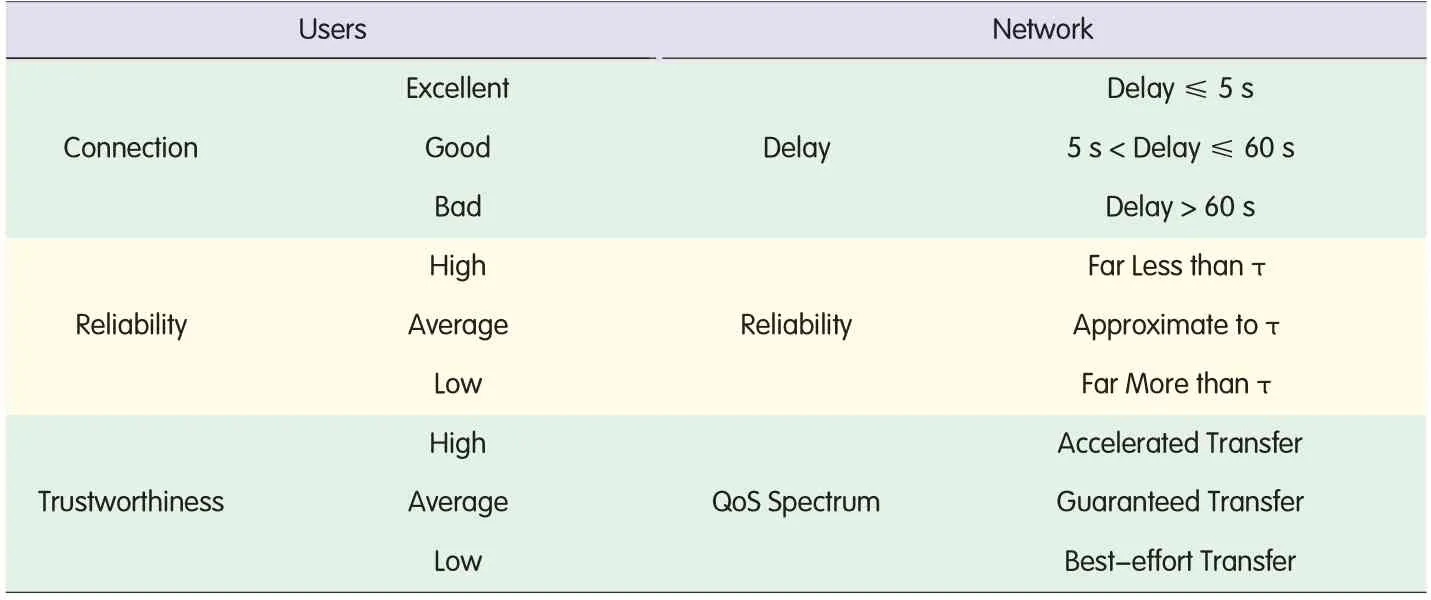
▼Table 1. Mapping relationship between users and network.
The provider QoShas three data attributes:delay,reliability and QoS spectrum.
The requester QoSalso has three data attributes:connection,reliability and trustworthiness.The connection attribute can be excellent,good or bad.The reliability and trustworthiness attributes are high,average and low.As shown in Figure 8,the service profile model can effectively distinguish QoSlevels,which is a foundation for fulfilling the personalization and diversification of user services.
4 Conclusion
The current Internet is rapidly developing,and new types of Internet services are emerging one after another.Under such a background,the port number in the Internet is temporarily and accidentally used as an identifier for service distinguishing.However,it brings such shortcomings as poor security and limited application.Anew network architecture,“universal Network and Pervasive Services”,has been proposed to effectively solve the problem of pervasive services in the Internet.This paper discussed the mechanisms and key technologies for pervasive services,created a unified identifier for different Internet services,defined the concept of service identifier,and classified the service identifier into the service-end service identifier and the client-end service identifier to provide different users with different QoSlevels.The service profile model verifies the feasibility of introducing the service identifier with QoSsupport into the network.

